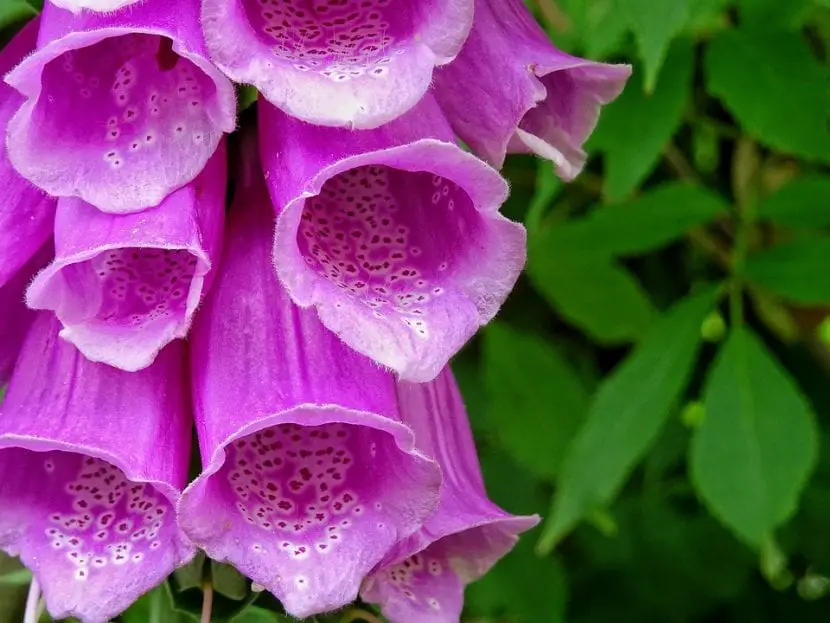
The plant known as digitalis purpurea It is very popular in temperate climate gardens, because although its life cycle is only two years, it produces such an abundance of flowers that it makes cultivation worthwhile.
What’s more, you can even have it in a pot, something that you will surely love to know if you don’t have land to plant it or if you simply want to decorate your patio or terrace with such a floriferous species. Get closer to their world .
Origin and characteristics

It is a biannual plant -lives two years- native to Europe, northwestern Africa and central and western Asia whose scientific name is digitalis purpurea. It is popularly known as foxglove, digital, cartridge, sucker, bilicroques, gauntlet, staxon or viluria. To date, it has become naturalized in South America, specifically in Chile and Argentina.
Reaches a height of up to 2,5 meters including the flower stem. During the first year it forms a rosette of basal leaves, oval in shape and with a toothed margin, and the second year the flower stalk appears covered with sessile leaves. The flowers are grouped in terminal hanging clusters, and are tubular, up to 5cm long and with a color ranging from pale yellow to purple. Blooms in summer. The fruit is a capsule, filled with seeds.
All its parts are toxic.
There are different subspecies:
- D. purpurea subsp. bocquetii
- D. purpurea subsp. folder
- D. purpurea subsp. mariana
- D. purpurea subsp. mauretanica
- D. purpurea subsp. purple
- D. purpurea subsp. purple var. nevadensis
- D. purpurea subsp. purple var. take away
- D. purpurea subsp. purpurea var. stormy
- D. purpurea subsp. amandian
- D. purpurea subsp. doubt
- D. purpurea subsp. thapsi
What are their cares?

If you dare to have a copy, we recommend that you provide it with the following care:
Location
Foxglove is a plant that needs to be abroad to feel the passing of the seasons. But also, it is important that it is in full sun, except if you are going to have it in the Mediterranean, which then it would be better to be sheltered.
Earth
- the garden: grows in soils rich in organic matter, loose, fertile and slightly acidic. In the limestone and compact it does not go too well (I tell you from experience).
- Flower pot: I advise putting a first layer of clay, volcanic clay, washed river sand or similar to improve drainage, and then finish filling it with universal cultivation substrate.
Irrigation
Irrigation must be controlled a lot, since it does not tolerate waterlogging but neither does drought. Therefore, if you do not have much experience caring for plants and / or if you prefer to be on the safe side, You must check the humidity of the soil before proceeding to water itfor example with a digital humidity meter or a thin wooden stick (if when you remove it you see that not much soil has adhered to it, water).
Another option, if you are going to have it in a pot, is to weigh it once watered and again after a few days. This way you will notice that when the substrate is freshly watered it weighs more than when it is dry, so you can use this difference in weight to know when to water.
Use rainwater, no lime. In case you don’t have a way to get it, add two tablespoons of vinegar to 5l / water; or the liquid of half a lemon in 1l / water. Stir well and voila, it will be ready to use.
Subscriber

It is necessary to pay it in spring and summerBoth the first year so that it has strength and health, and the second so that it can produce its precious flowers. You can use organic fertilizers in powder if it is in the garden, such as compost for example; On the other hand, if it is in a pot, use liquid fertilizers, like this one from here!, following the instructions specified on the package to the letter.
Pruning
You just have to cut the dry leaves and withered flowers. If you want it to bloom again, remove the flower stem as soon as you see that it is drying; thus it is very likely that it will flourish again.
Multiplication
The digitalis multiplies by seeds in spring. The way to proceed is as follows:
- The first thing to do is fill a seedling tray with universal growing medium.
- Then, water conscientiously, and sow a maximum of two seeds in each socket.
- Then cover them with a thin layer of substrate.
- Now, water with a sprayer.
- Finally, place the seedbed outside, in semi-shade.
If all goes well, the first seeds will germinate in 2 weeks.
Planting or transplanting time
In spring. If it is potted, transplant as soon as roots come out of the drainage holes and only if it is not flowering.
Plagues and diseases
It’s very toughBut aphid and Red spider They are two pests that you can have in dry conditions. Both are treated with diatomaceous earth or potassium soap.
Also, if overwatered and / or leaves are sprayed, fungi will cause grayish-brown spots to appear. You have to avoid this, and treat with fungicides if you already have this problem.
Rusticity
It resists cold and frost well up to -7ºCIt is also interesting to know that if the growing conditions are adequate, it tends to reseed .

What did you think of digitalis purpurea?
